3 666
THE NUMBER OF IRON MAIDEN, 1981–1982
“[Heavy metal] is a place to dream of adventures: running free through the hills, forever getting girls on their knees, scrapping with Satan, battling with vermin and swimming through space…. Monsters, tanks, reptiles, rapists, maniacs, murderers, thugs roam the territory, but it’s never for real, they’re all harmless—HM is an extremely soft land, the monsters and the maniacs are really just teddy bears and dolls.”
—Paul Morley,
NME, May 8, 1982
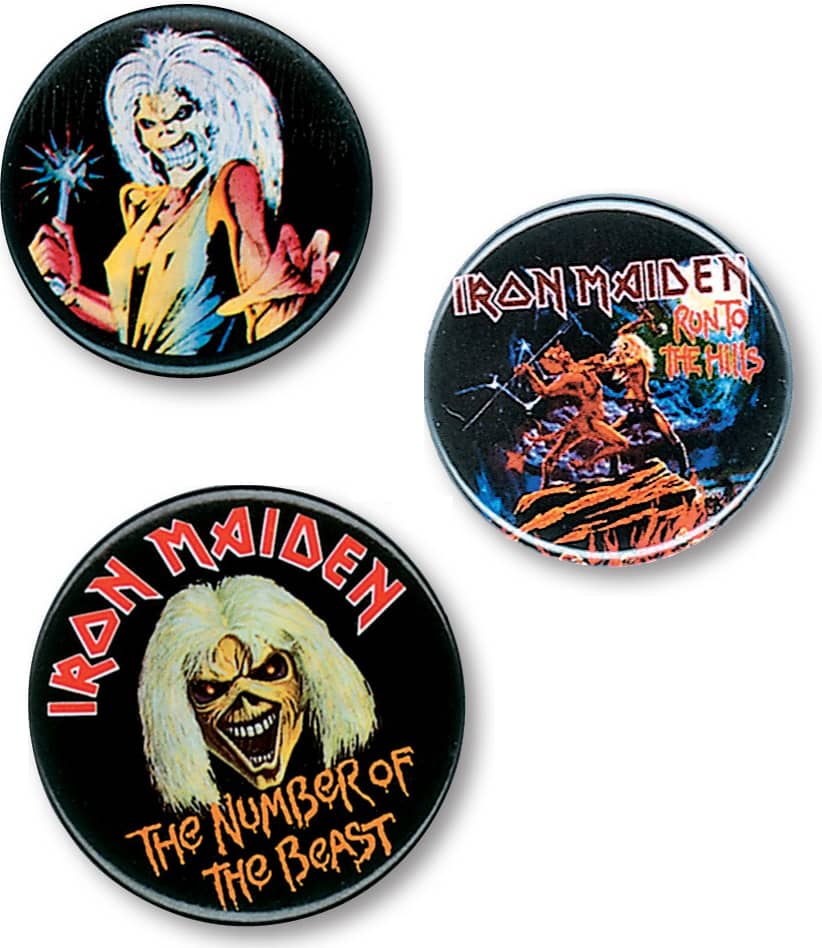
Songs that Steve Harris had left over from the first album provided the backbone for Maiden’s second full studio album, Killers. Harris had also been busy writing songs on tour so that by the time recording for Killers commenced in November 1980, he only needed to write two more tracks, “Murders in the Rue Morgue” (an homage to Edgar Allan Poe) and “Prodigal Son.” Only the title track features a co-credit (with Paul Di’Anno).
Killers was the first Iron Maiden album produced by Martin Birch, who would become an important member of Maiden’s extended family. The band hit Battery Studios in London in late 1980 and came out three months later with a brand-new album.
The making of Killers is not without its interesting anecdotes, one of them involving former Maiden drummer Barry “Thunderstick” Purkis. Killers and Samson’s Head On (the first Samson LP to feature a certain Bruce Dickinson on vocals) were recorded at separate studios within close proximity of each other. Maiden drummer Clive Burr nipped ’round to Paul Samson’s house to have a listen to Head On and to play Killers for him. The similarities between “Thunderbust,” one of the new Samson tracks, and “The Ides of March,” an instrumental track on Killers, were apparent; both Paul Samson and Clive Burr could not believe it. Could Purkis, Samson’s current drummer, be responsible? Indeed, “Ides” had been around in rough format for some time—parts of the song had been used as an intro tape at gigs prior to the recording of the album. Thunderstick was summoned to the London headquarters of Maiden’s record label, EMI. In 2009, Thunderstick recalled the scene for rock scribe Joe Geesin:
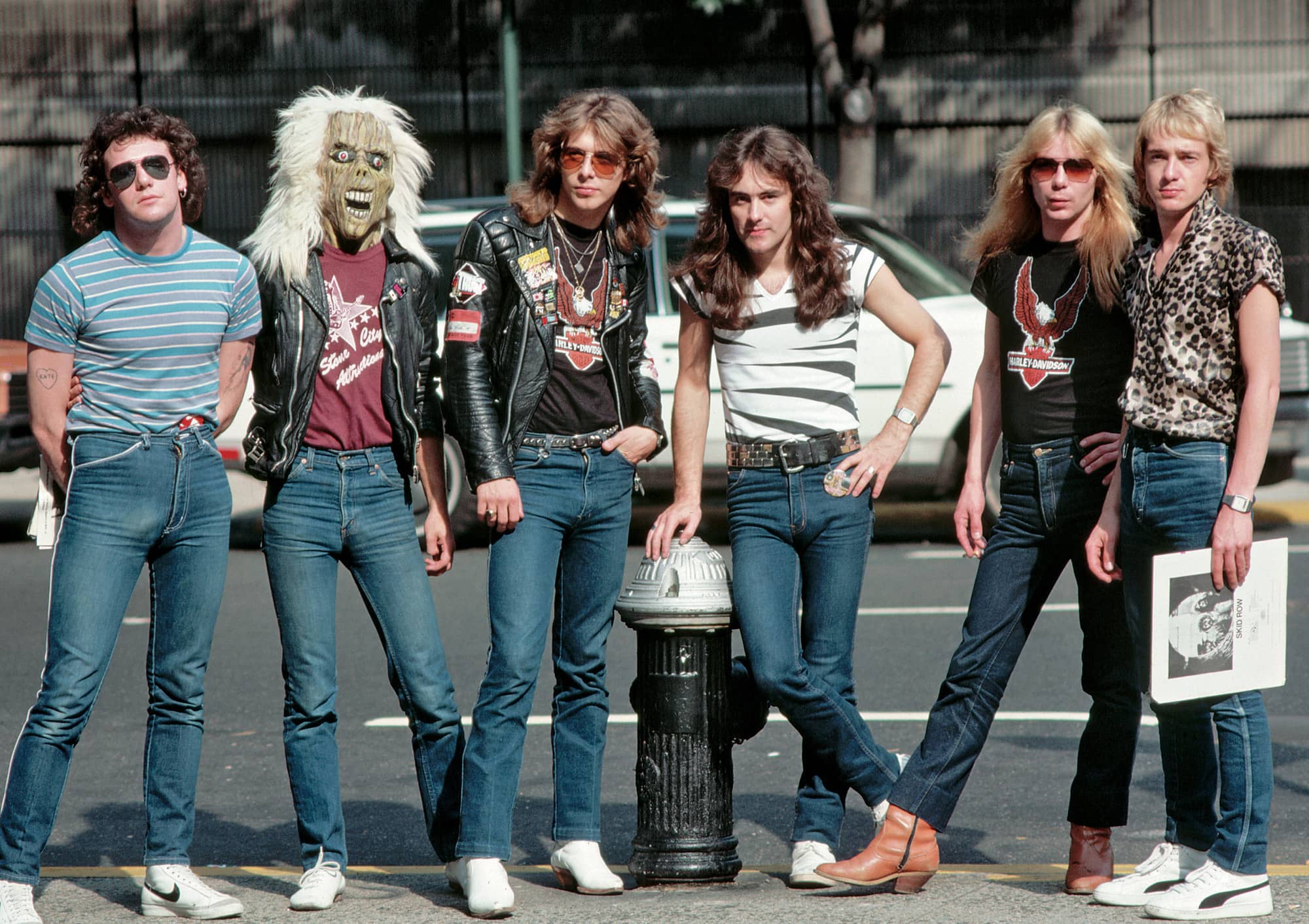
Maiden on the mean streets of New York, 1981. © Denis O’Regan/CORBIS

There was Rod Smallwood, Steve Harris, and Iron Maiden’s lawyer/solicitor and an EMI representative sitting opposite me. I was on my own. Samson’s then-management had seen fit that I didn’t require representation.
It was decided upon that Steve Harris would share fifty/fifty publishing rights on the Samson version and I would get sweet F.A. [f*** all] on the Iron Maiden version. Due to the fact that there are no lyrics on either track there is no true fifty/fifty split required. However on the Samson version there is the singing mask with me going “aaaahaaaa” in the background. Does that constitute vocals? Probably not! Does it leave a sour taste in my mouth? You betcha!”
Thunderstick wasn’t the only one with a sour taste. Killers did not sit right with Maiden vocalist Paul Di’Anno, either. “[Killers] wasn’t quite there for me … and to be frank, at that age I wasn’t also handling things as well as the other guys who were older than me,” he told Shan Siva of battlehelm.com. “One minute I was a kid off the street and the next I was expected to handle things like it was sliced bread. Needless to say, I started drinking a lot and I must’ve done half of Peru up my nose. I screwed up … I wasn’t happy, both with the album and myself and I really didn’t wanna be there.”
Released in the U.K. in February 1981 and in the United States in June of that year, Killers represented a big step forward from the first album. The band reworked the now classic Maiden track “Wrathchild,” which had been featured on the Metal for Muthas compilation. Other iconic tracks that Killers spawned included the title track and “Purgatory,” the latter a remake of an earlier (and slower) Maiden song called “Floating” that they played live in the very early days.
In support of the album, Maiden launched the Killers world tour in February 1981, and an extensive road trek that brought the band to the United States for the first time (a territory they were eager to crack) and yielded the live EP Maiden Japan later that year. Japan had always been a stronghold for British heavy metal bands, and Maiden was building up a fan base there. As Steve Harris told Night Rock News’ Gueniviere the following year, “Everywhere we traveled, there were loads and loads of screaming girls. I mean, it was unbelievable, just screamin’! Guys, as well, would run right down the road and start bangin’ on the windows…. It was absolutely ridiculous!”
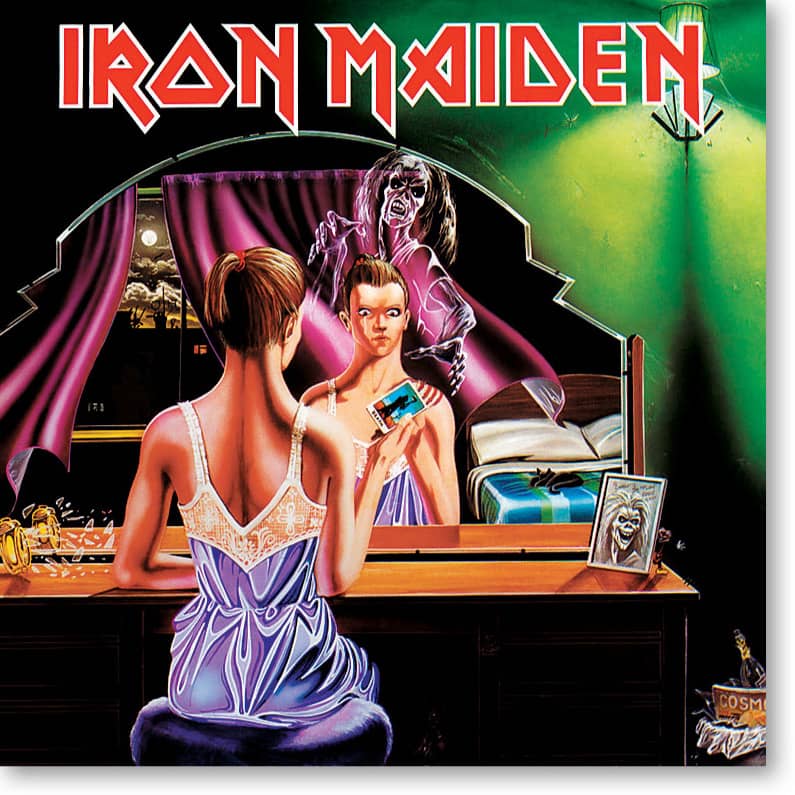
“Twilight Zone” (March 1981).
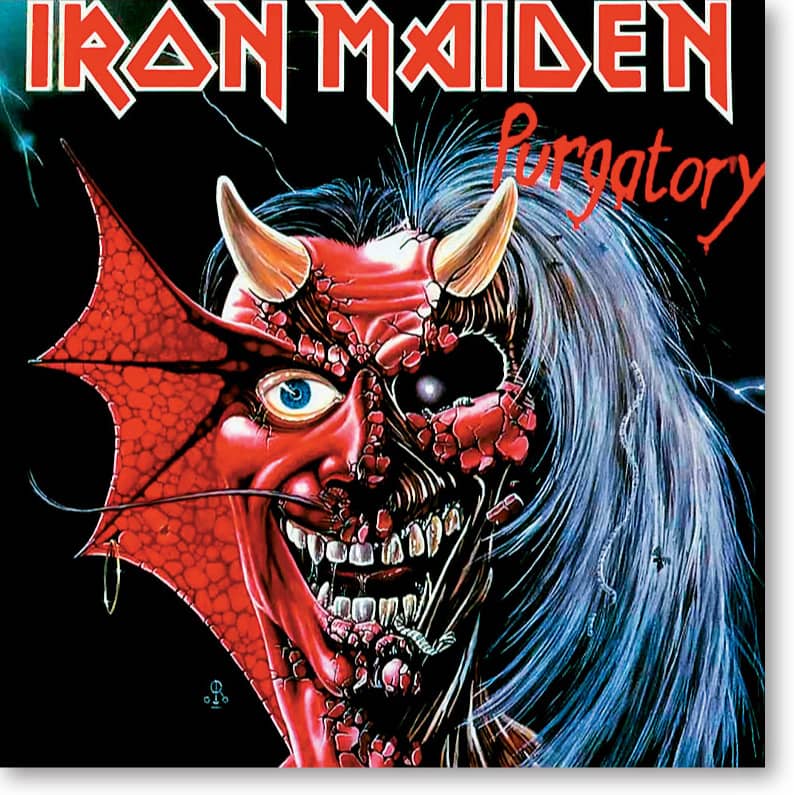
“Purgatory” (June 1981).
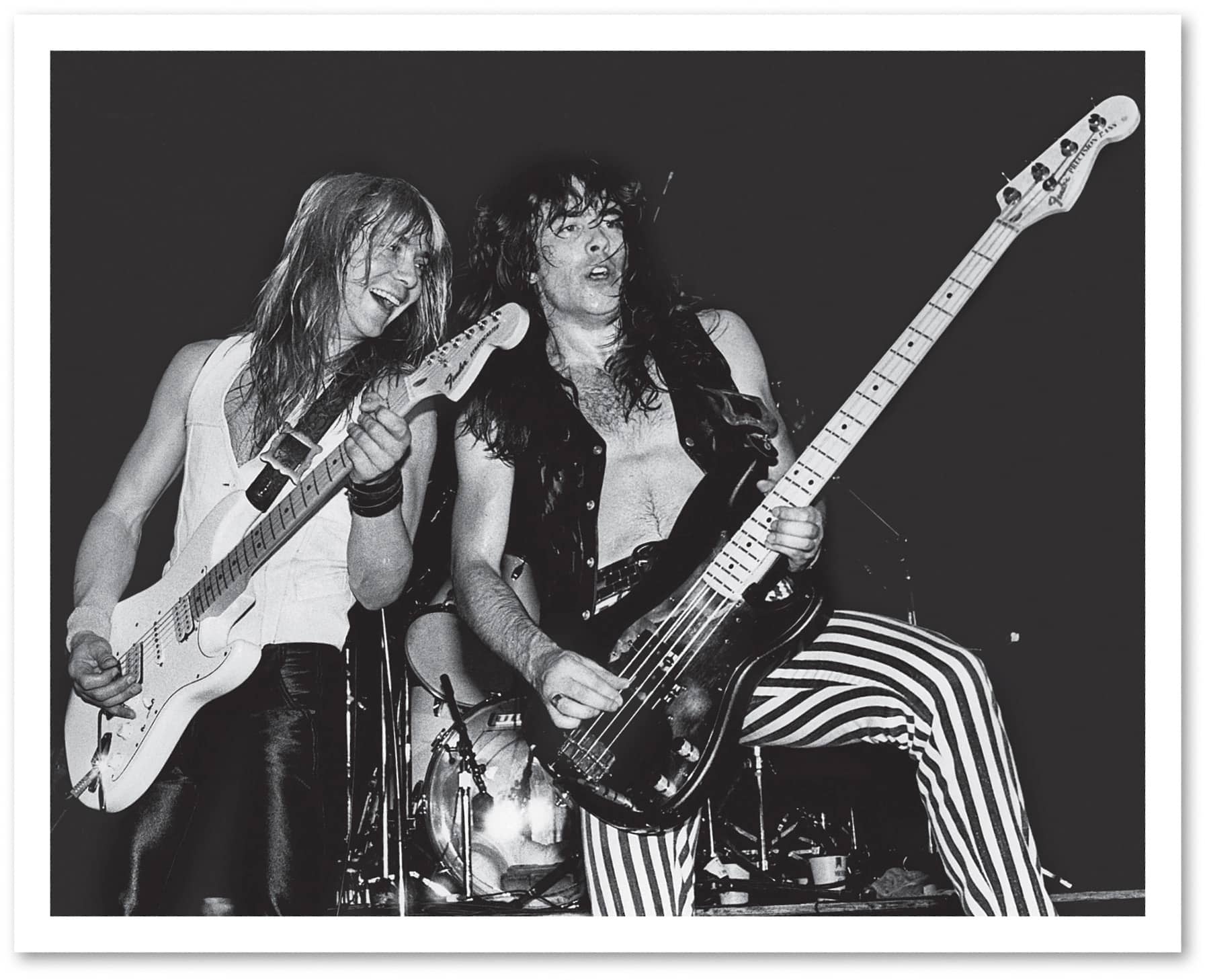
Killers world tour, Largo, Maryland, July 1, 1981. Ebet Roberts/Redferns/Getty Images
Back in the United Kingdom, Maiden’s strongest support was found far from their East End haunts in the north of England and parts of Scotland. “In the early years, it was always Manchester, Glasgow, and Liverpool—those really hardworking areas where football and music meant a lot to people, because they didn’t have a lot of prospects then,” Adrian Smith told Chris Vinnicombe (musicradar.com).
How had Smith settled into the band?
“Well, on the Killers album, Adrian was very new and it really wasn’t until he’d been with the band about a year and a half that he really felt he was a full member,” Harris told Kevin Thompson of Artist Magazine in 1983. “He always had been, but he never really seemed to accept that it was happening. [Perhaps] because he went from a local band in the East End to Iron Maiden, which, even at the time, was quite a big act. It took him quite a while to settle in, and it also took both he and Dave a long time to get the right guitar sounds.”
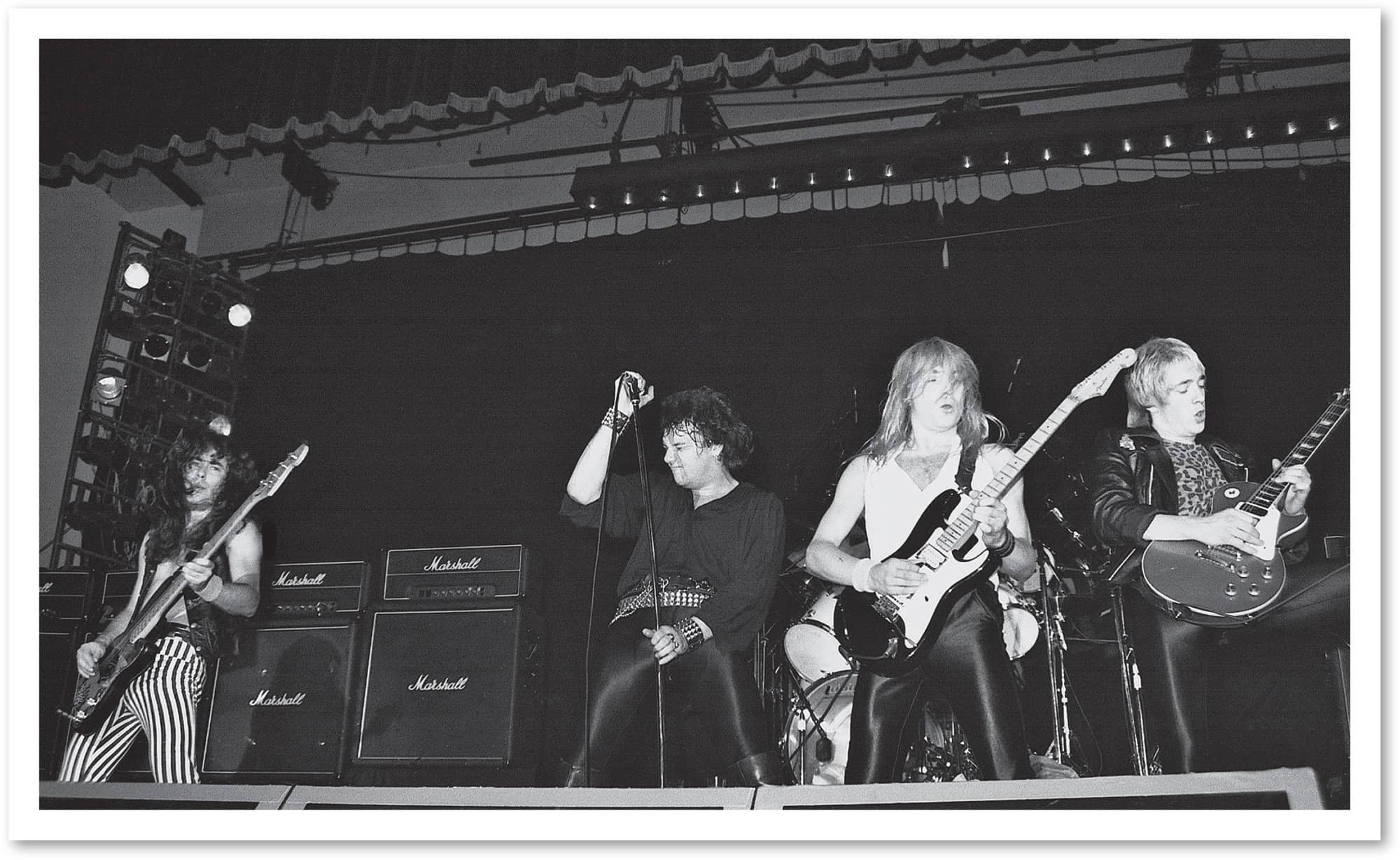
Killers world tour, Asbury Park, New Jersey, July 2, 1981. © Bob Leafe
But a bigger problem than guitar interplay loomed: Di’Anno was battling his own personal demons on tour, and his backstage antics and alleged lack of passion and drive onstage did not go unnoticed. Harris and manager Rod Smallwood decided to let Di’Anno go in the fall of 1981.
Di’Anno’s last live gig with Maiden was on September 10, 1981, in Copenhagen. “Actually, I have good memories of Maiden,” Di’Anno reminisced to Shan Siva, “meeting all the people on tours, playing live on Top of the Pops, and the fact that we were part of something happening the way we mixed hardcore punk with heavy metal.”
Still, Di’Anno continues to refute the long-perceived notion that he was ousted because of drugs. “Where the fuck do you people get this from?” he asked at a press conference in Argentina in 2009 while touring with his RockFellas project. “I left Iron Maiden because they were going too heavy metal, and Iron Maiden is a money-making machine, and I don’t give a fuck about it. It was not about drugs—it was nothing like that.”
With Di’Anno sacked, Maiden needed somebody committed to the cause and the tough task of touring. A new singer was sought immediately to help fulfill remaining dates on the Killers tour. “We had about a thousand tapes sent in, and we had about twelve people come down for the audition,” Dave Murray told Gary James in 1999.
One of those twelve hopefuls was a young Bruce Dickinson, who sang “Remember Tomorrow” at his audition, impressing both the band and Smallwood. The former Samson singer made his first appearance as Maiden’s new frontman in Bologna on October 26. A new chapter had opened in the Iron Maiden saga.

The Killers world tour was an extensive road trek that brought Iron Maiden to the United States for the first time. Frank White Photo Agency
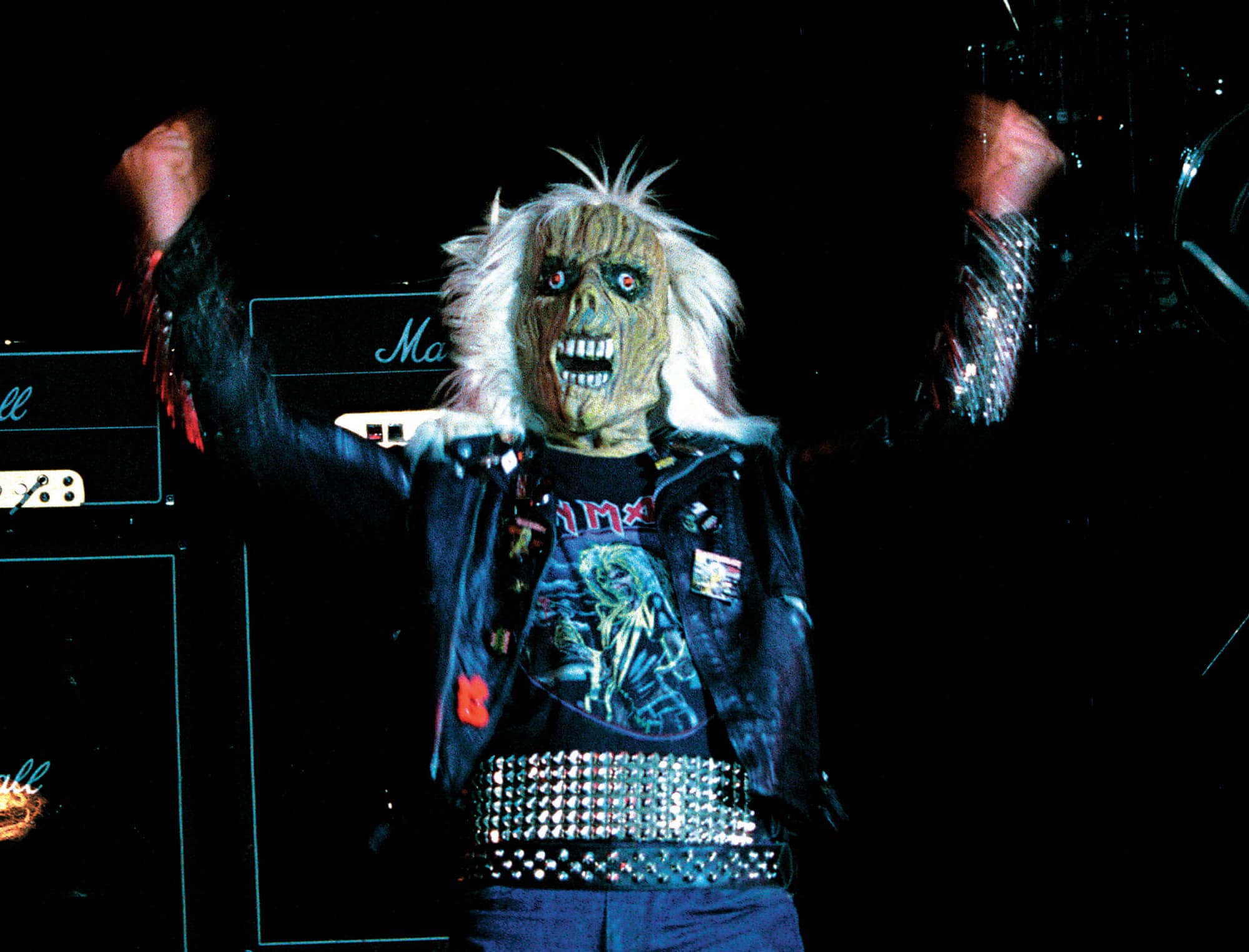
Eddie at Maiden’s opening slot for Judas Priest at the Palladium in New York City, July 23, 1981. © Larry Marano/Retna ltd.
“[Dickinson] suits their style right down to the ground,” Di’Anno later told Siva. “Also, I’m too hardcore for Maiden. My attitude is totally different and I’d always rub them up the wrong way—I’m an antagonistic muthafucker ’cos I want a reaction from people…. And there’s no way you could get me into spandex again man, not for a million fuckin’ dollars—it’s so Spinal Tap.”
Bruce Dickinson was born Paul Bruce Dickinson on August 7, 1958, in Worksop, Nottinghamshire. Initially raised by his grandparents, Dickinson moved with his parents to Sheffield, a tough, industrialized working-class city in the northeast of England. After difficulties at his new school, his parents enrolled him at a private school called Sharrow Vale Junior. Still, he felt like an outsider, and many feelings of isolation experienced in Sheffield would surface later in his lyrics, particularly in his solo work.
Dickinson’s first band was a local outfit called Styx (which bared no resemblance to the American AOR band of which he was probably not even aware).
“My first excuse for a band was while I was at school,” Dickinson reflected in 1983, speaking to Kevin Thompson. “I had a pair of bongos. We did ‘Smoke on the Water,’ and I used to beat the crap out of those bongos because we didn’t have a drum kit. The band realized that the singer couldn’t sing, so I got the job—mainly to stop the noise of the bongos! We played in each other’s bedrooms, annoying our mums and dads.”
Dickinson grew up listening to American rock ’n’ roll legends like Chuck Berry and Elvis Presley but he also liked British bands, namely the Beatles and Gerry & the Pacemakers. As he got older, heavy rock bands like Deep Purple and Led Zeppelin attracted his attention.
Sixties Britain was filled with heavy rock bands—male, white, and predominantly working-class—that were inspired by traditional pre- and postwar American blues artists like Buddy Guy, John Lee Hooker, and B. B. King. Bands like the Who, the Yardbirds, and the Kinks, and later Cream and Deep Purple, formed part of the so-called British Invasion that swept through the United States. Dickinson soaked up these new, heavier blues-tinged rock sounds.

Killers world tour, Palladium, New York City, July 24, 1981. © Dean Messina/Frank White Photo Agency (above) and © Frank White (below)

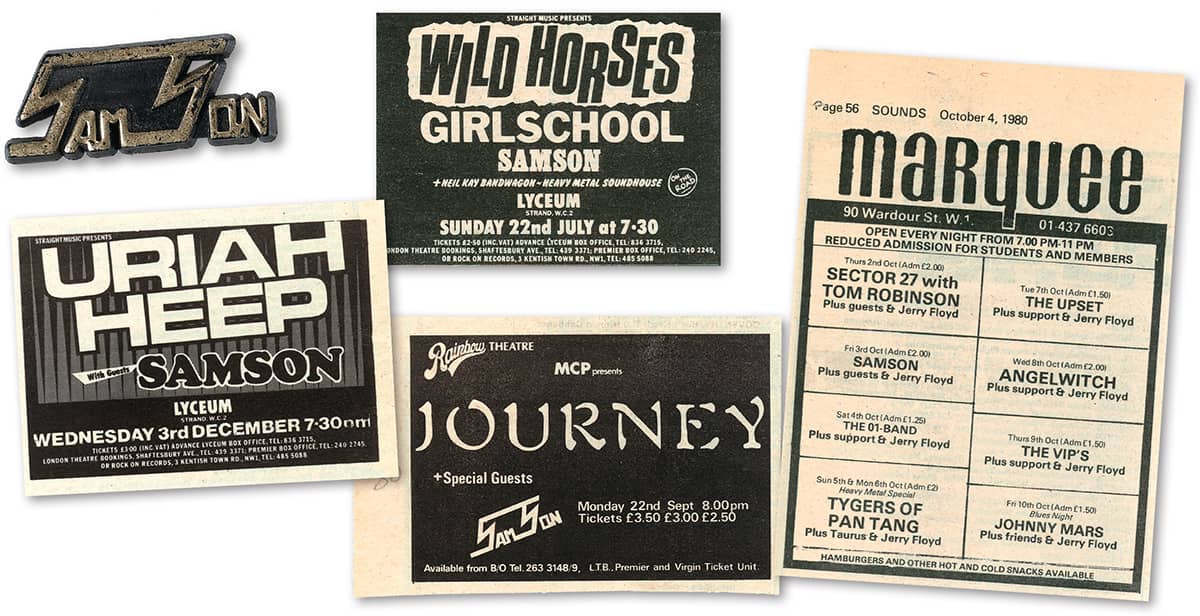
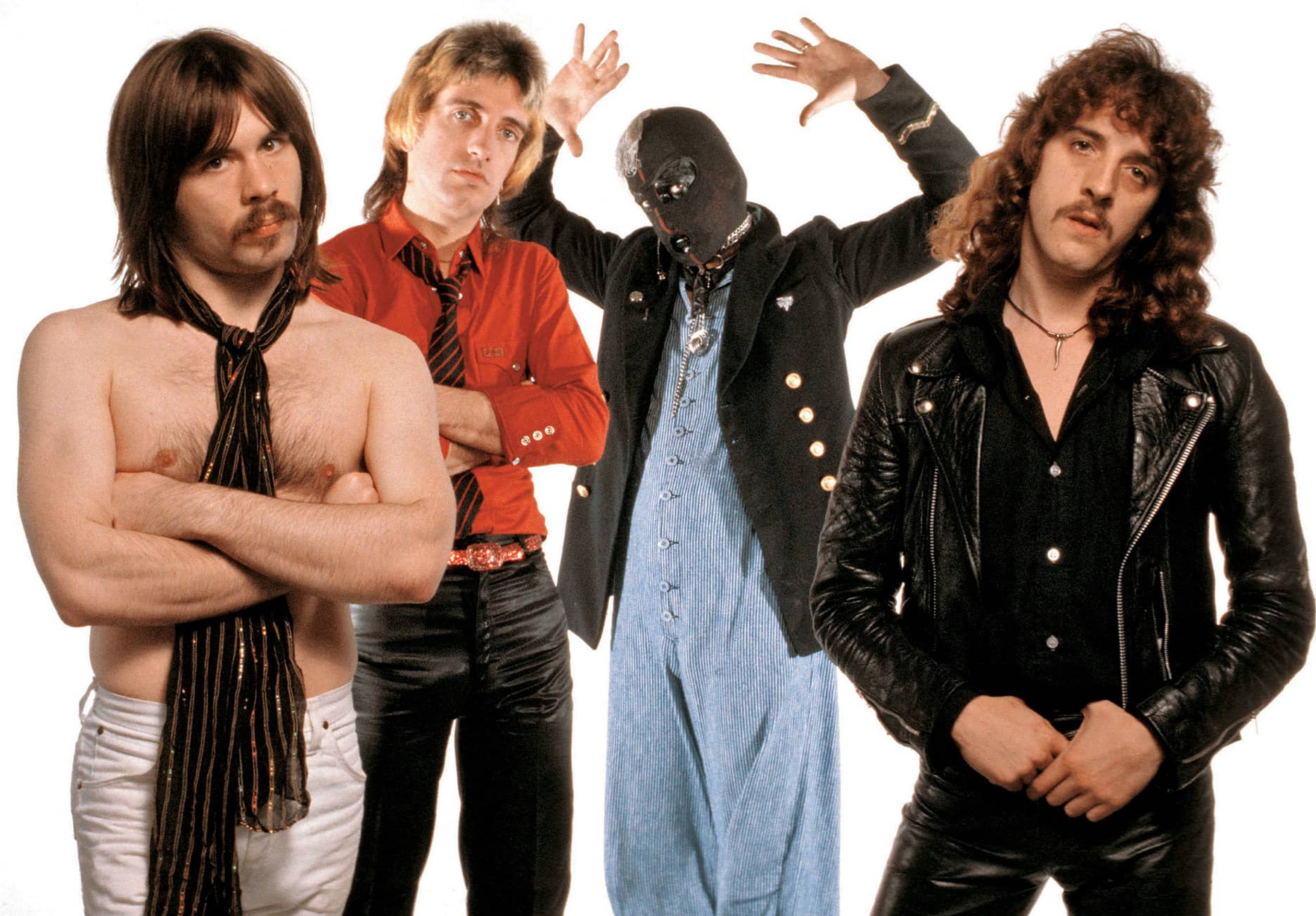
By the time Bruce Dickinson left Samson due to the commonly cited “musical differences,” he had witnessed the strict work ethic and taut organization that made the Maiden wheel spin. From left: Dickinson, Chris Aylmer, Barry “Thunderstick” Purkis, and Paul Samson. Fin Costello/Redferns/Getty Images
Leaving the Territorial Army after six months of service, Dickinson moved to London to study history at Queen Mary College. There he met likeminded musicians and found himself first in a band called Speed in 1977, and later, in 1979, in a band called Shots. However, it was with the hard rock outfit Samson that he made a real impression. By the time Dickinson left Samson in ’81, due to the commonly cited musical differences and internal friction, he had witnessed the strict work ethic and taut organization that made the Maiden wheel spin.
“On the first two albums we had a lot of material lying around from before we got signed,” Steve Harris told Kevin Purcell of aquarian.com years later. “On the third album [The Number of the Beast], there was absolutely nothing, and we had a specific period of time to write and a load of pressure to write. It worked great, so that’s what we’ve done ever since. If you were to allow yourself a year to write, you would get distracted and do a lot of other stuff in between. When you’re stuck into it, you get to it.”
The band began recording The Number of the Beast in late 1981 and wrapped it up in January 1982, again with producer Martin Birch at the helm. Asked what it was like working with Birch, in 1982 Adrian Smith told respected rock writer Steven Rosen, “Great. He doesn’t try to make it a Martin Birch album. The very first thing he said to us was, ‘This is your album. I’m just going to try and bring out what’s there.’ He’s not too pushy or he doesn’t try changing the songs. He just gets a good sound and then we just get on with it. If we start slacking, he kicks us then!”
The album featured songwriting credits from Adrian Smith and Clive Burr but not from Dave Murray; and because of contractual obligations with Samson, Dickinson was not able to receive songwriting credits.
The Number of the Beast was released in February 1982 in the United Kingdom, where it hit No. 1 on the album chart and gave the band major exposure around the globe. The album was released in the United States in June of that year. It has since become one of the most talked about albums in heavy metal history and cemented the band’s status as one of metal’s greatest creations. Indeed, The Number of the Beast has sold more than 14 million copies worldwide and continues to shift a healthy number of copies yearly, thanks in part to its frequent inclusion on “greatest albums” lists.
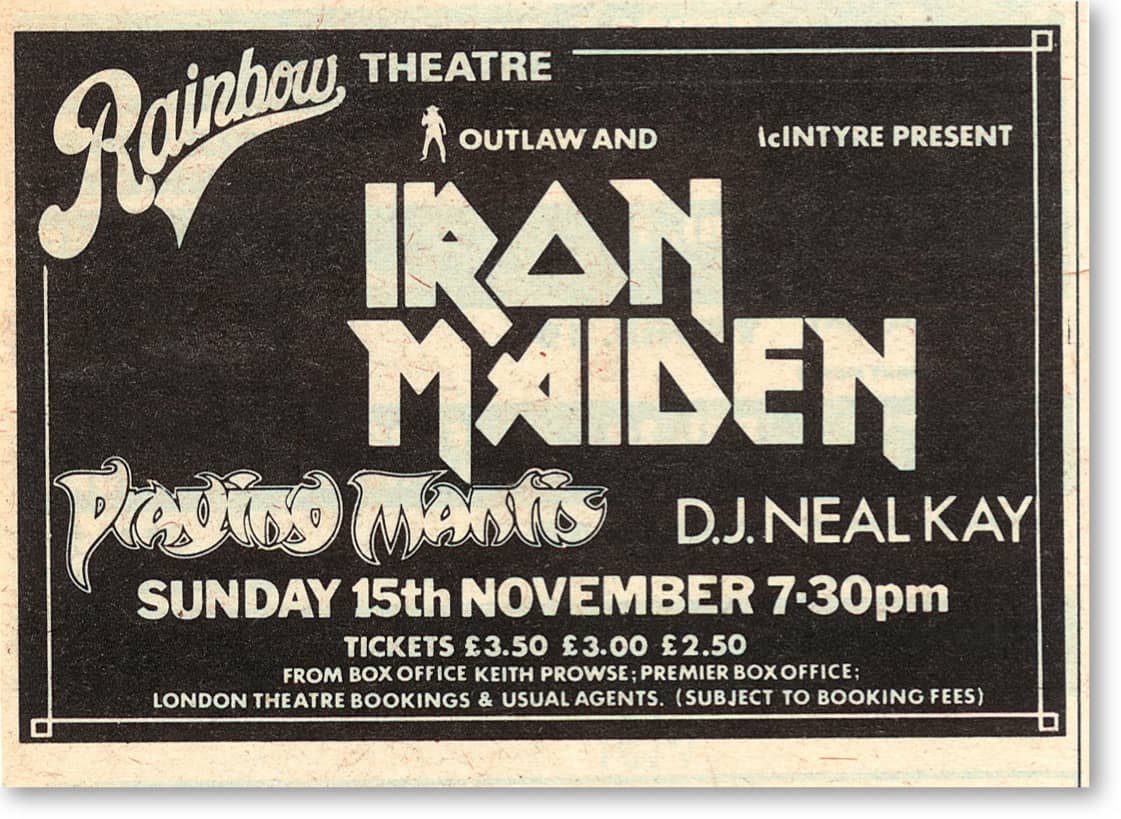
The band wound down 1981 with a new singer and two London shows—one in December and this Rainbow gig in mid-November.
The album’s success has also no doubt been abetted by the controversy it incited among some American Christian fundamentalists, who attacked misperceived connections with the occult. Such protests completely missed the point that it was all very tongue-in-cheek. After all, writing about romance and love was not something that interested Iron Maiden.
“I don’t think we’ve ever written anything that is romantic,” Harris told Night Rock News at the time. “Everyone writes about how they want to love their ‘baby’ and all that! People write about how hard it is on the road, which it is hard, and how lonely they get, which it is true, what they’re saying…. But I find that a bit boring. I mean, frankly, it’s a bit sort of … wimpy, I think. That’s not to say I don’t sort of have any romance in me at all. It’s not that. But I just don’t think something like that is what I particularly want to write about.”
The same conservatives who objected to Iron Maiden also attacked Ozzy Osbourne and, later, Judas Priest. Many years later, Dave Murray reflected on the controversy with interviewer Joe Matera (2007): “We’re definitely not devil worshippers. I think it all started because of The Number of the Beast album. When it came out, a lot of the people who didn’t like that sort of thing just started gravitating towards that album in particular. And though it became a big issue at the time, it wasn’t as big as people made out it to be. But we basically ignored it and left it alone.”
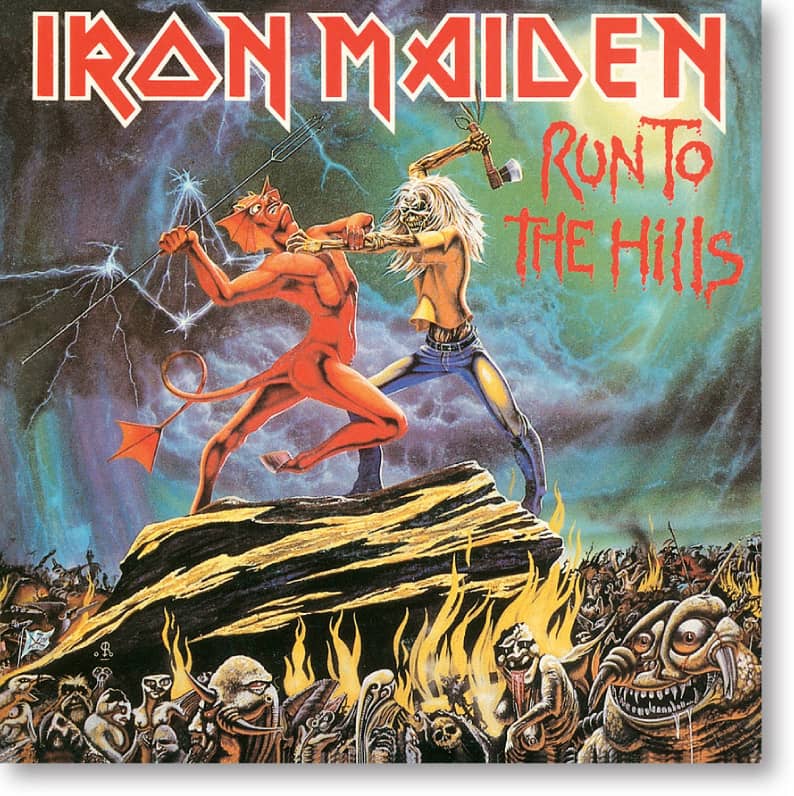
“Run to the Hills” (February 1982).
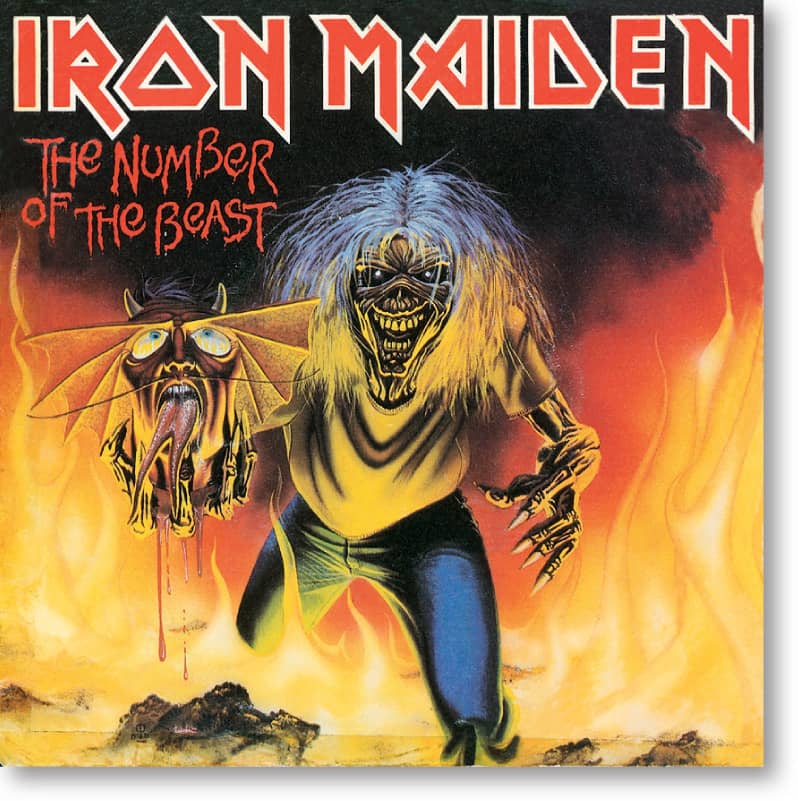
“The Number of the Beast” (April 1982).
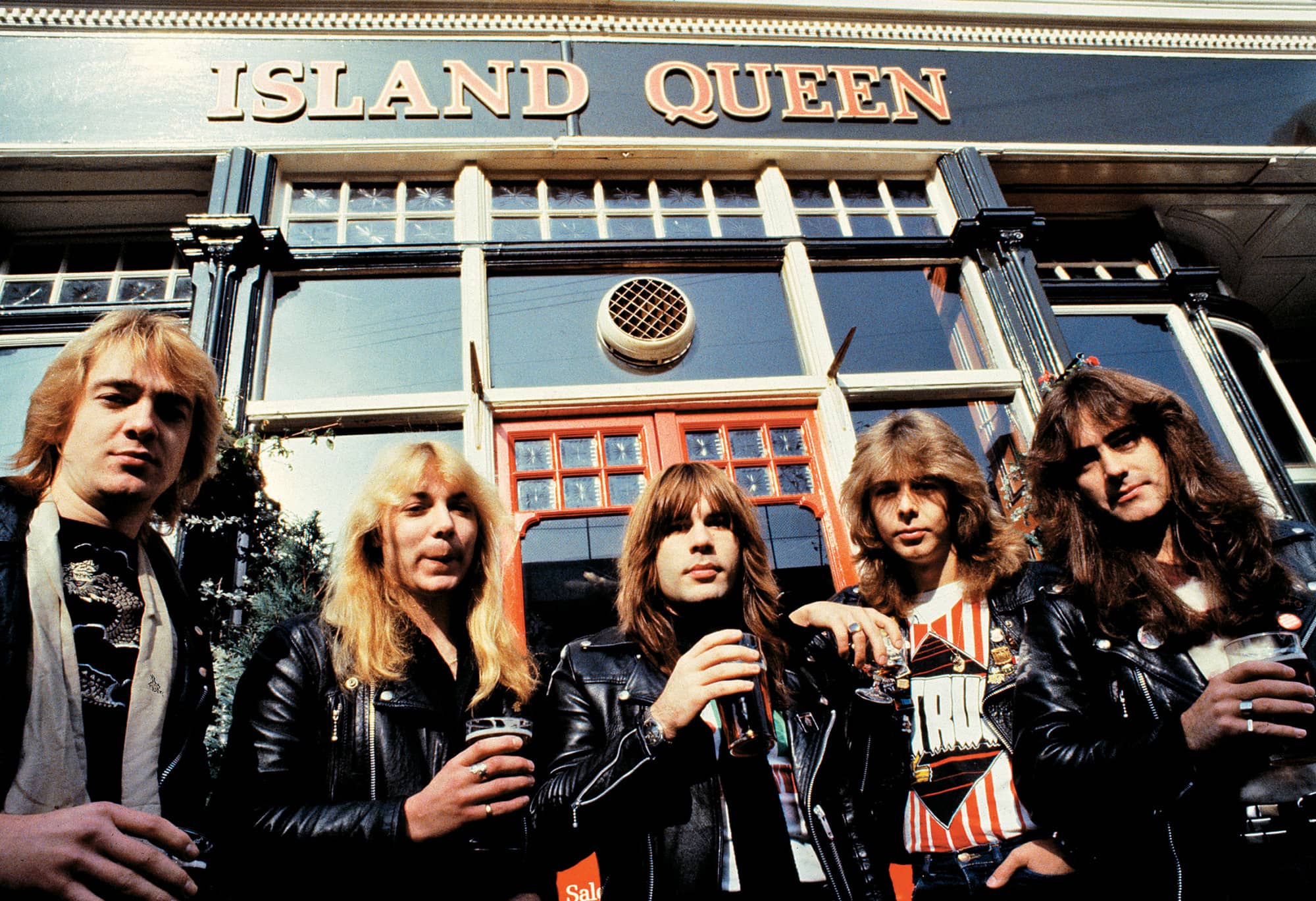
Outside the Island Queen pub in Islington, London, 1982. Michael Putland/Getty Images
To promote the album the band had launched the Beast on the Road tour in February 1982, which remains one of their longest tours to date with close to two hundred shows played worldwide. “We’ve never got much radio play at all—we’ve always made our reputation as a band on the road,” Murray told Chris Vinnicombe.
In addition to an important gig at the famed Reading Festival in August, where Dickinson made his presence felt in front of thousands of music fans, Maiden toured extensively around the United States, supporting Rainbow on their Straight Between the Eyes tour, the Scorpions on their Blackout tour, and Judas Priest on their Screaming for Vengeance trek. Maiden also played some headlining shows in the States, further opening a huge market for the band.
Around this time, guitarists Murray and Smith began making a huge impression on the metal scene, and were now often mentioned in the same breath and revered tones as Judas Priest’s K. K. Downing and Glenn Tipton.
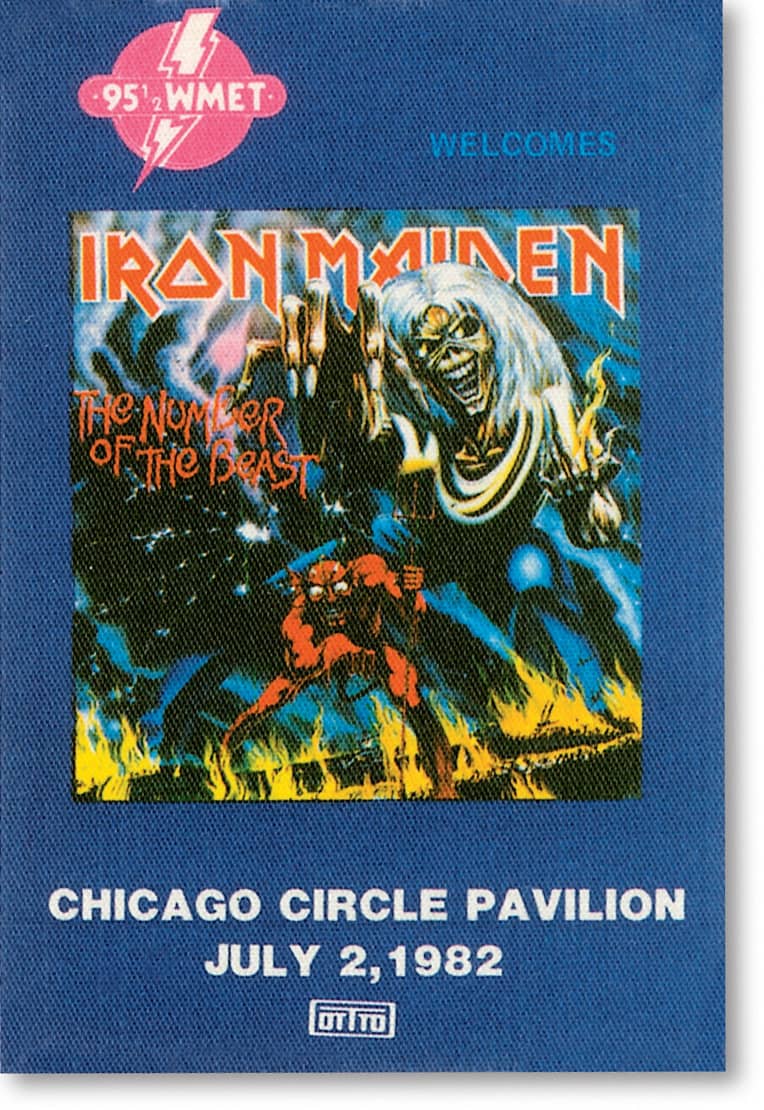
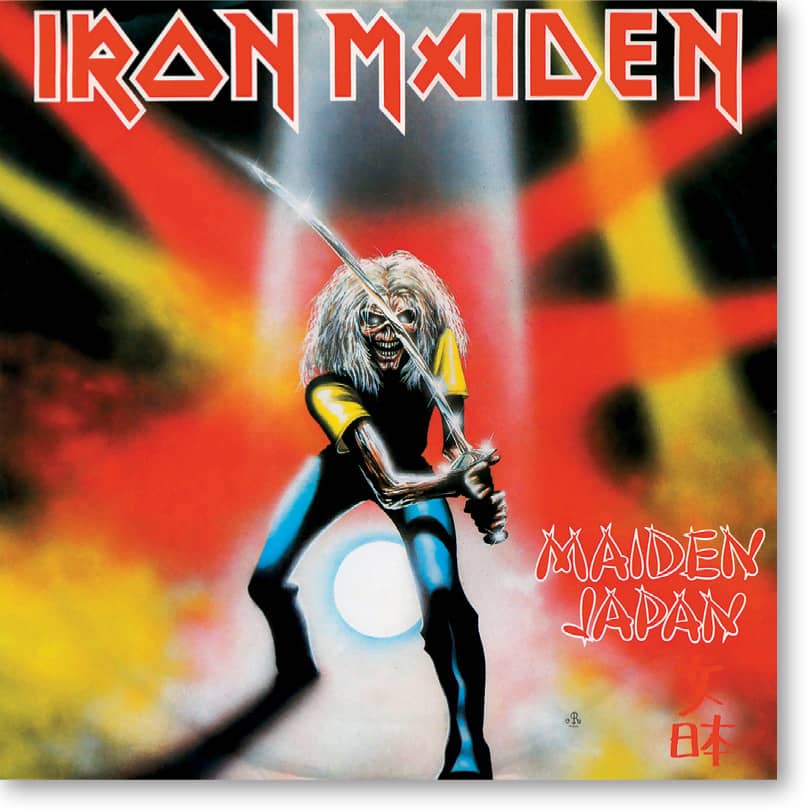
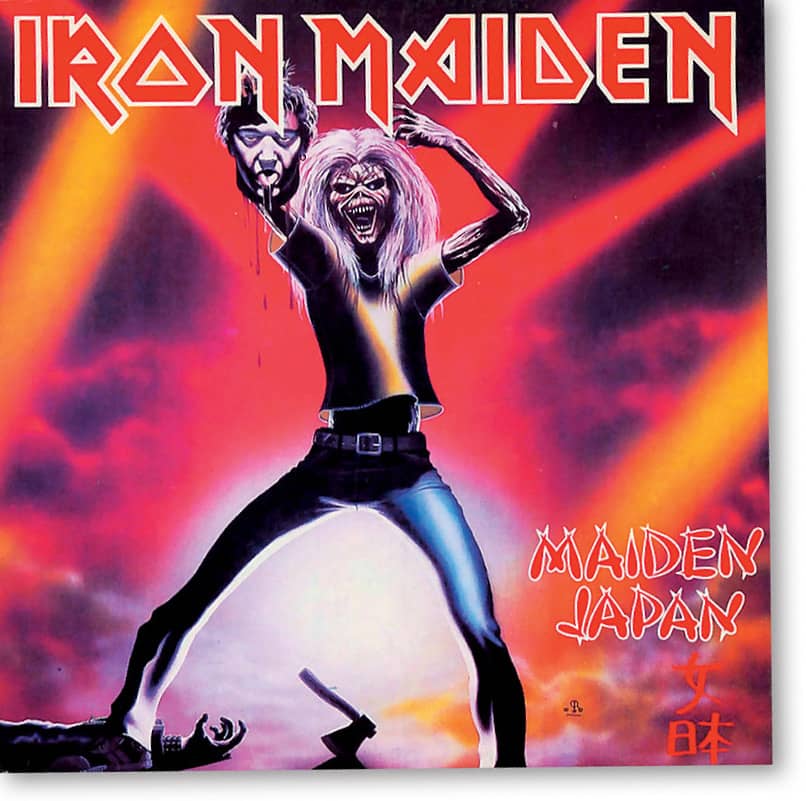

Beast on the Road world tour, Madison Square Garden, New York City, October 2, 1982. © Bob Leafe
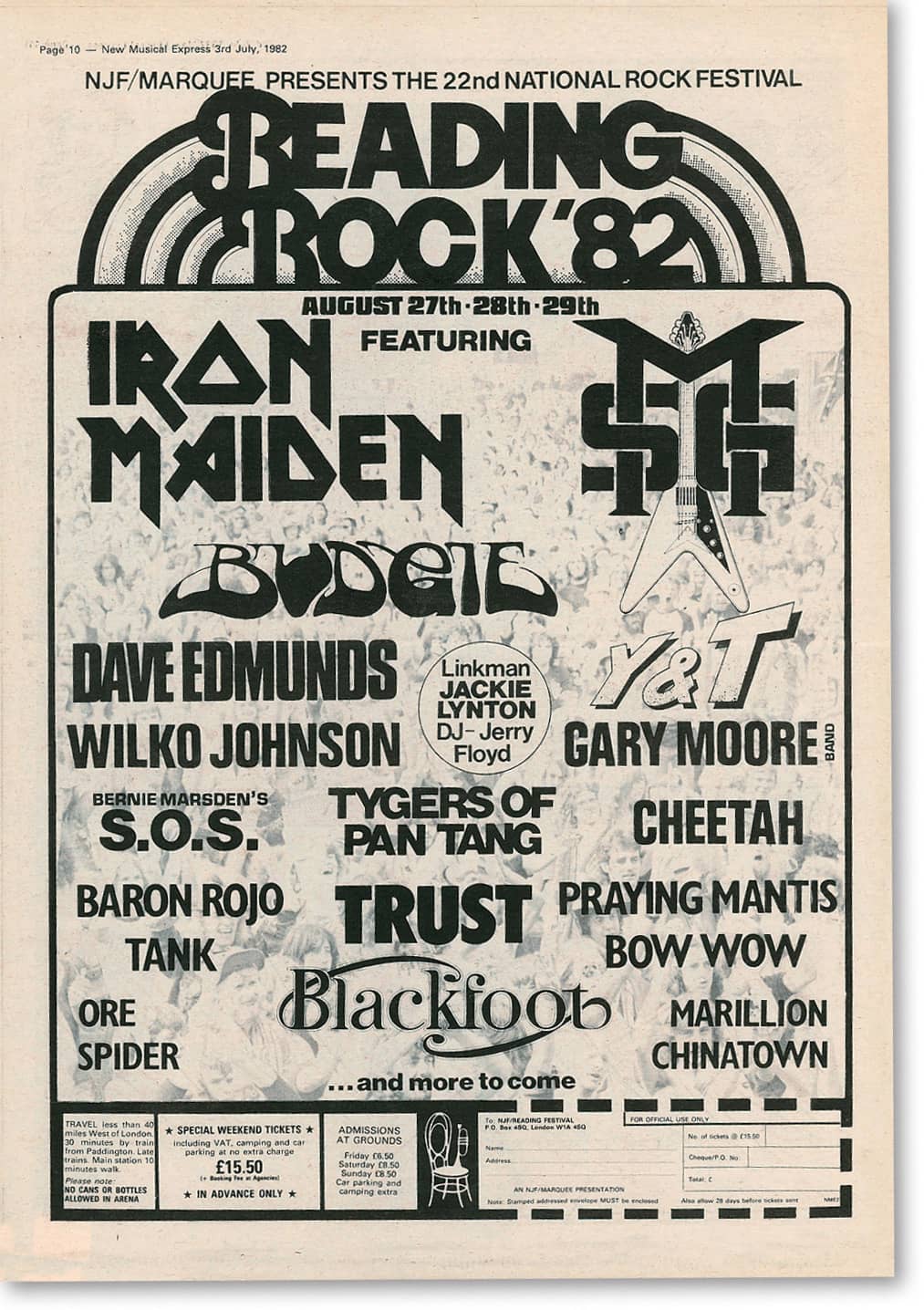
As Smith told Rosen in 1982, “Dave grew up with a lot of Hendrix. You go down to his house anytime and he’ll be playing that. So his approach is wah wah and lots of whammy bar, very, very fast. I tend to, when I do a solo in the studio, I’ll just like work it out. Then I’ll put it down and maybe I’ll keep it. Dave will just rip it out three or four at once.”
The year ended with Clive Burr announcing that he had to leave the band due to personal issues and the hectic touring schedule that the band had committed to. Faced with a second consecutive end-of-year personnel change, the band tapped stickman Michael Henry “Nicko” McBrain.
“[Nicko’s] drumming is some of the best rock drumming there is,” Harris told Kevin Thompson in 1983. “His feel is magic. Nicko toured with us when he played with the French band Trust in 1981 and ’82. So he’s been on the road with us. Trust and Iron Maiden have always been big friends anyway, and personality-wise there was no problem. He was actually born about a mile and a half from me, and he’s just a couple of years older than I am. His drumming, I think, has given us a different dimension. It’s tougher, and his timing is perfect. He’s a total rock drummer; he’s got a great feel and he hits it real hard.”
By the time January rolled around, the band was ready to commence work on the new album that would feature the most famous and steady line-up in Maiden’s history: singer Bruce Dickinson, bassist Steve Harris, guitarists Dave Murray and Adrian Smith, and drummer Nicko McBrain. 
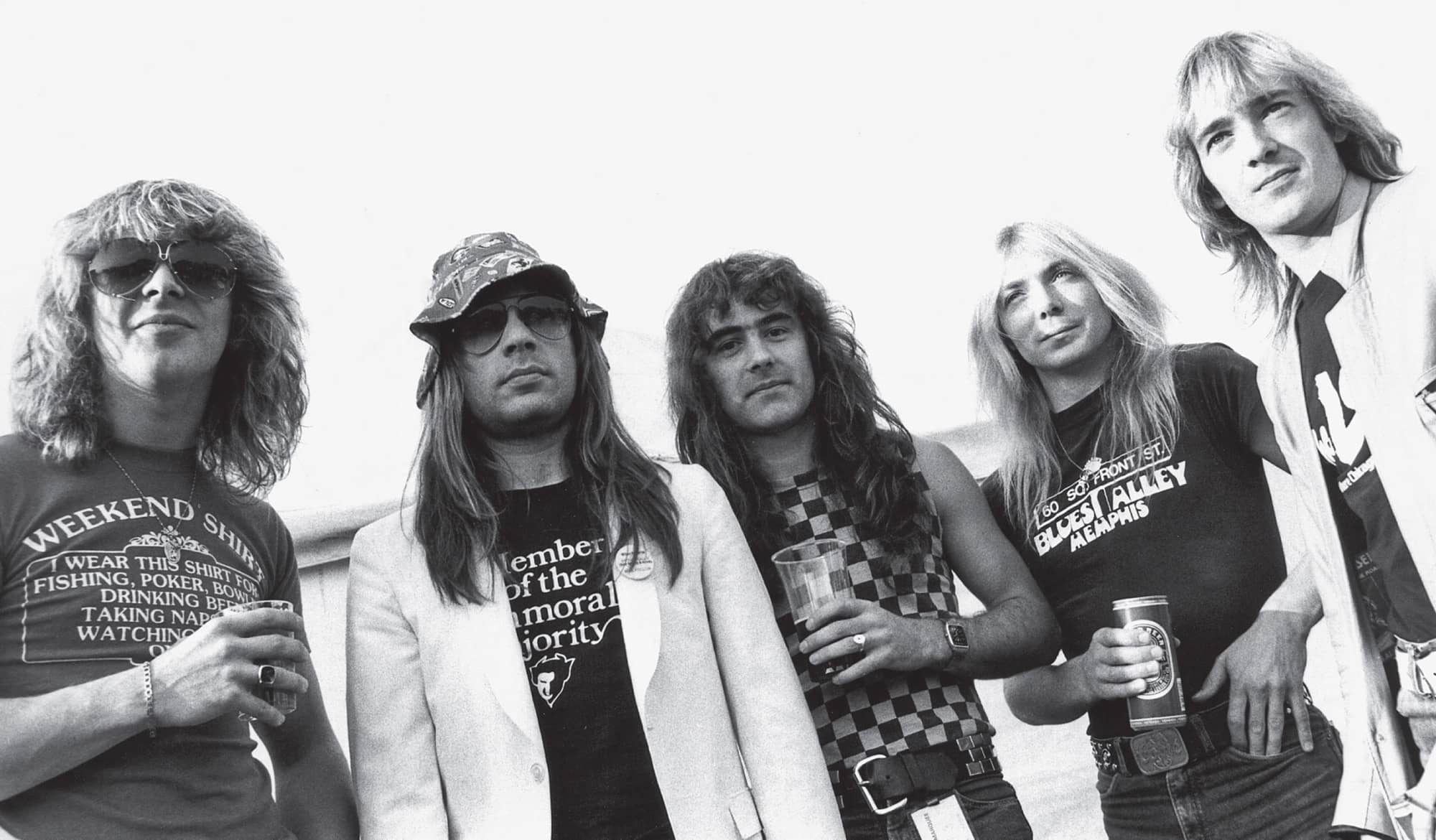
Iron Maiden were road warriors in 1982, sandwiching three U.K. shows into the middle of their North American tour, including an August 28 appearance at the famed Reading Festival, where they are seen here. Four days later they were playing Long Beach, California. © Steve Rapport/Retna Ltd.

The Killers world tour yielded the live EP Maiden Japan (August 1981). The Venezuelan cover featured Eddie holding aloft the decapitated head of recently departed Paul Di’Anno. Pressings issued in the United States, Canada, New Zealand, Australia, Argentina, and Brazil featured “Wrathchild” in addition to “Running Free,” “Remember Tomorrow,” “Killers,” and “Innocent Exile.”
All courtesy Wyco Vintage/wycovintage.com

1981 By Ryan LaMar
02.17 |
Ipswich, GBR |
02.18 |
Norwich, GBR |
02.19 |
Oxford, GBR |
02.20 |
Lancaster, GBR |
02.21 |
Derby, GBR |
02.22 |
Manchester, GBR |
02.23 |
Hanley, GBR |
02.24 |
Dunstable, GBR |
02.26 |
Guildford, GBR |
02.27 |
Bristol, GBR |
02.28 |
Taunton, GBR |
03.01 |
Bournemouth, GBR |
03.02 |
Southampton, GBR |
03.04 |
Bradford, GBR |
03.05 |
Liverpool, GBR |
03.06 |
Middlesborough, GBR |
03.07 |
Newcastle, GBR |
03.08 |
Glasgow, GBR |
03.09 |
Edinburgh, GBR |
03.10 |
Sheffield, GBR |
03.12 |
Birmingham, GBR |
03.13 |
Cambridge, GBR |
03.14 |
Bracknell, GBR |
03.15 |
Hammersmith, GBR |
03.18 |
Lille, FRA |
03.19 |
Le Havre, FRA |
03.20 |
Rheims, FRA |
03.21–22 |
Paris, FRA |
03.23 |
Lyon, FRA |
03.24 |
Miramar, FRA |
03.25 |
Toulon, FRA |
03.26 |
Nice, FRA |
03.27 |
Montpellier, FRA |
03.30 |
Milan, ITA (two shows) |
03.31 |
Reggio Emilia, ITA |
04.01 |
Brescia, ITA |
04.02 |
Gorizia, ITA |
04.03 |
Turin, ITA |
04.05 |
Zurich, SUI |
04.06 |
Erlangen, GER |
04.07 |
Dusseldorf, GER |
04.10 |
Hamburg, GER |
04.11 |
Bremen, GER |
04.12 |
Wertheim, GER |
04.14 |
Karlsruhe, GER |
04.15 |
Stuttgart, GER |
04.16 |
Mannheim, GER |
04.17 |
Strasbourg, FRA |
04.18 |
Mulhouse, FRA |
04.19 |
Douvaine, FRA |
04.21 |
Colomiers, FRA |
04.22 |
Bordeaux, FRA |
04.23 |
Le Mans, FRA |
04.24 |
Genk, BEL |
04.25 |
Antwerp, BEL |
04.26 |
Leiden, NED |
04.28 |
Nijmegen, NED |
04.29 |
Offenbach, GER (possibly rescheduled from 04.09) |
05.21 |
Tokyo, JPN |
05.22 |
Osaka, JPN |
05.23 |
Nagoya, JPN |
05.24 |
Tokyo, JPN (two shows) |
06.03 |
Las Vegas, USA |
06.04 |
Phoenix, USA |
06.05 |
El Paso, USA |
06.06 |
Odessa, USA |
06.07 |
Lubbock, USA |
06.09 |
McAllen, USA |
06.10 |
Laredo, USA |
06.11 |
San Antonio, USA |
06.13 |
Dallas, USA |
06.14 |
Houston, USA |
06.19 |
Detroit, USA |
06.21 |
Toronto, CAN |
06.22 |
Montreal, CAN |
06.26 |
Milwaukee, USA |
06.27 |
Lynnwood, USA |
06.28 |
Cleveland, USA |
07.01 |
Largo, USA |
07.02 |
Asbury Park, USA |
07.03 |
Salisbury, USA |
07.04 |
Norfolk, USA |
07.07 |
Pittsburgh, USA |
07.09 |
Myrtle Beach, USA |
07.10 |
Atlanta, USA |
07.11 |
Johnson City, USA |
07.12 |
Memphis, USA |
07.15 |
Dayton, USA |
07.16 |
Johnstown, USA |
07.17 |
Buffalo, USA |
07.18 |
Rochester, USA |
07.19 |
Syracuse, USA |
07.21 |
Albany, USA |
07.22–24 |
New York City, USA |
07.25 |
New Haven, USA |
07.26 |
Allentown, USA |
07.28 |
Boston, USA |
07.29 |
Baltimore, USA |
07.30 |
Philadelphia, USA |
08.01 |
San Bernardino, USA |
08.04 |
Long Beach, USA |
08.15 |
Stuttgart, GER |
08.16 |
Nuremberg, GER |
08.23 |
Darmstadt, GER |
08.26 |
Frejus, FRA |
08.27 |
Cap d’Agde, FRA |
08.29 |
Bayonne, FRA |
08.31 |
Annecy, FRA |
09.01 |
Orange, FRA |
09.06 |
Belgrade, YUG |
09.08 |
Stockholm, SWE |
09.09 |
Lund, SWE |
09.10 |
Copenhagen, DEN |
10.26 |
Bologna, ITA |
10.27 |
Rome, ITA |
10.28 |
Firenze, ITA |
10.29 |
Padova, ITA |
10.30 |
Milan, ITA |
11.15 |
London, GBR |
12.23 |
East Ham, GBR |
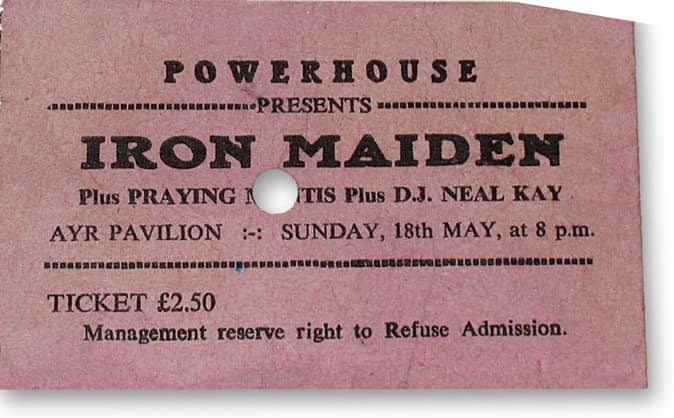
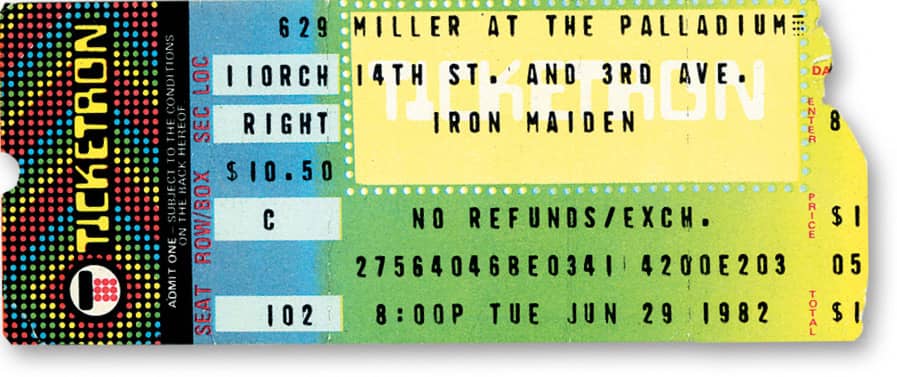
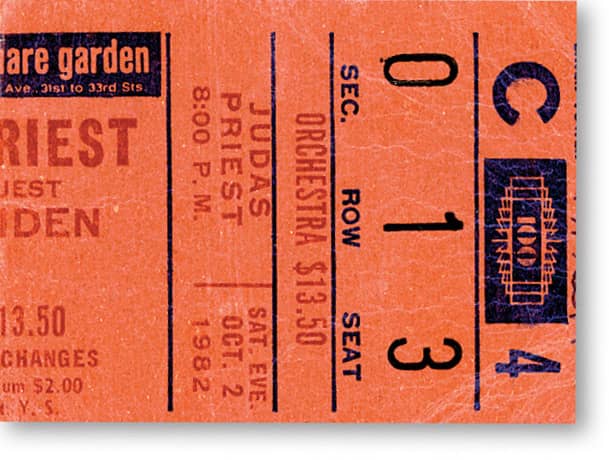
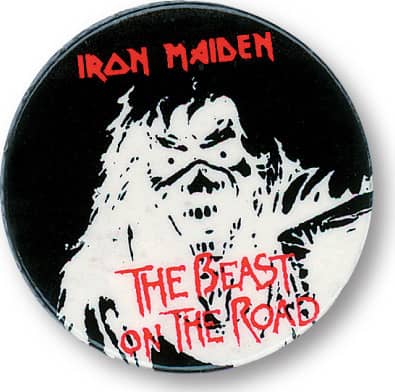
Evidence has shown the following dates, which have appeared elsewhere, including the European tour program, to be unreliable:
03.30 |
Bologna, ITA |
03.31 |
Milan, ITA |
04.01 |
Udine, ITA |
04.02 |
Bresca, ITA |
04.06 |
Munich, GER |
04.07 |
Frankfurt, GER |
04.08 |
Cologne, GER |
04.08 |
Neu Isenberg, GER |
04.09 |
Kassel, GER |
04.10 |
Berlin, GER |
04.12 |
Wurtzburg, GER |
04.13 |
Mannheim, GER |
04.14 |
Villingen, GER |
04.15 |
Karlsruhe, GER |
04.16 |
Erlangen, GER |
04.21 |
Tolouse, FRA |
04.23 |
Orleans, FRA |
04.29 |
Bremen, GER |
04.29 |
Berlin, GER |
04.30 |
Hannover, GER |
05.03 |
Hamburg, GER |
05.22–24 |
Tokyo, JPN |
05.25 |
Nagoya, JPN |
05.29 |
Sidney, AUS |
05.31 |
Melbourne, AUS |
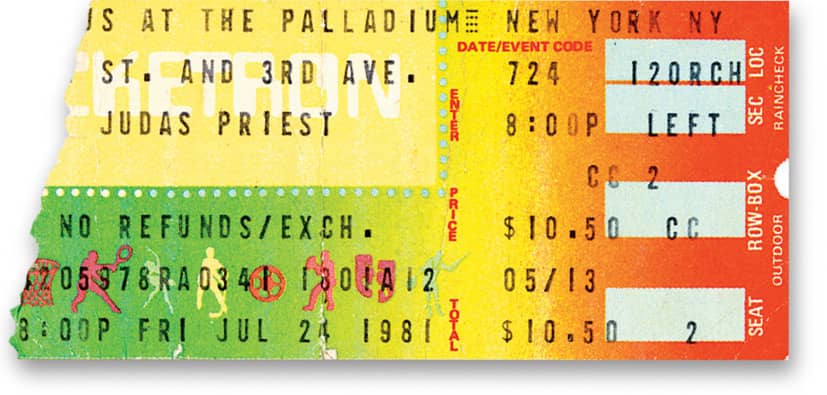
1982
02.25 |
Dunstable, GBR |
02.26 |
Huddersfield, GBR |
02.27 |
Wolverhampton, GBR |
02.28 |
Hanley, GBR |
03.01 |
Bradford, GBR |
03.03 |
Liverpool, GBR |
03.04 |
Manchester, GBR |
03.05 |
Leicester, GBR |
03.06 |
Birmingham, GBR |
03.08 |
Portsmouth, GBR |
03.09 |
Oxford, GBR |
03.10 |
Derby, GBR |
03.11 |
Bristol, GBR |
03.12 |
Bracknell, GBR |
03.14 |
Glasgow, GBR |
03.15 |
Edinburgh, GBR |
03.16 |
Newcastle, GBR |
03.17 |
Sheffield, GBR |
03.19 |
Ipswich, GBR |
03.20 |
Hammersmith, GBR |
03.22 |
Reims, FRA |
03.23 |
Lille, FRA |
03.24 |
Paris, FRA |
03.26 |
Lyon, FRA |
03.27 |
Clermont-Ferrand, FRA |
03.28 |
Nice, FRA |
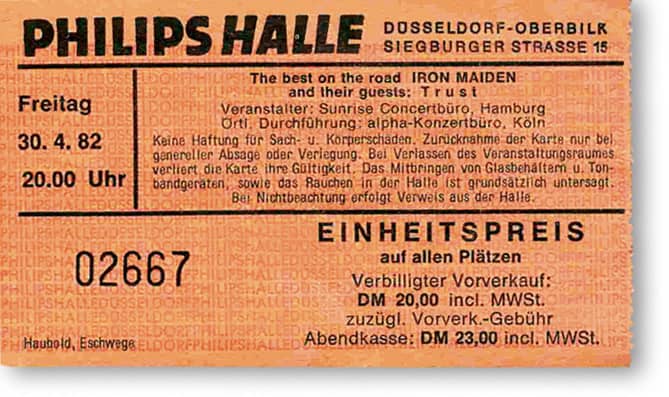
03.30 |
Montpellier, FRA |
03.31 |
Toulouse, FRA |
04.02 |
Barcelona, ESP |
04.03 |
Madrid, ESP |
04.04 |
San Sebastian, ESP |
04.05 |
Bergerac, FRA |
04.06 |
Le Mans, FRA |
04.07 |
Brest, FRA |
04.08 |
Poitiers, FRA |
04.09 |
Dijon, FRA |
04.10 |
Grenoble, FRA |
04.12 |
Winterhur, SUI |
04.13 |
Strasbourg, FRA |
04.16 |
Evry, FRA |
04.17 |
Rouen, FRA |
04.18 |
Brussels, BEL |
04.20 |
Hannover, GER |
04.21 |
Hamburg, GER |
04.22 |
Bochum, GER |
04.23 |
Wurzburg, GER |
04.24 |
Neunkirchen, GER |
04.26 |
Munich, GER |
04.27 |
Eppelheim, GER |
04.28 |
Offenbach, GER |
04.29 |
Stuttgart, GER |
04.30 |
Dusseldorf, GER |
05.01 |
Amsterdam, NED |
05.11 |
Flint, USA |
05.13 |
Lansing, USA |
05.14 |
Detroit, USA |
05.15 |
Kalamazoo, USA |
05.16 |
Ft. Wayne, USA |
05.18 |
Toledo, USA |
05.20 |
Cincinnati, USA |
05.21 |
Louisville, USA |
05.22 |
Cleveland, USA |
05.23 |
Indianapolis, USA |
05.25 |
Merillville, USA |
05.26 |
Davenport, USA |
05.29 |
Des Moines, USA |
06.01 |
Atlanta, USA |
06.02 |
Nashville, USA |
06.04 |
Birmingham, USA |
06.05 |
Huntsville, USA |
06.07 |
Knoxville, USA |
06.08 |
Columbus, USA |
06.09 |
Tallahassee, USA |
06.11 |
Memphis, USA |
06.12 |
Jackson, USA |
06.13 |
New Orleans, USA |
06.15 |
Little Rock, USA |
06.16 |
Tulsa, USA |
06.18 |
Shreveport, USA |
06.19 |
Norman, USA |
06.22 |
Ottawa, CAN |
06.23 |
Toronto, CAN |
06.24 |
Kingston, CAN |
06.25 |
Quebec City, CAN |
06.26 |
Montreal, CAN |
06.27 |
Philadelphia, USA |
06.29 |
New York City, USA |
06.30 |
Long Island, USA |
07.02 |
Chicago, USA |
07.03 |
Buffalo, USA |
07.04 |
East Troy, USA |
07.06 |
Danville, USA |
07.07 |
Cedar Rapids, USA |
07.09 |
St. Louis, USA |
07.10 |
Kansas City, USA |
07.11 |
Des Moines, USA |
07.14 |
Salt Lake City, USA |
07.16 |
Seattle, USA |
07.17 |
Anaheim, USA |
07.18 |
Oakland, USA |
07.20 |
Victoria, CAN |
07.21 |
Vancouver, CAN |
07.23 |
Edmonton, CAN |
07.24 |
Calgary, CAN |
07.26 |
Regina, CAN |
07.27 |
Winnipeg, CAN |
07.28 |
Fargo, USA |
07.30 |
Minneapolis, USA |
07.31 |
Springfield, USA |
08.01 |
Indianapolis, USA |
08.03 |
Cleveland, USA |
08.04 |
Columbus, USA |
08.05 |
Chicago, USA |
08.06 |
Louisville, USA |
08.07 |
Toledo, USA |
08.08 |
Memphis, USA |
08.10 |
Beaumont, USA |
08.11 |
Corpus Christi, USA |
08.13 |
Houston, USA |
08.14 |
Dallas, USA |
08.16 |
San Antonio, USA |
08.17 |
Odessa, USA |
08.18 |
El Paso, USA |
08.20 |
Albuquerque, USA |
08.21 |
Phoenix, USA |
08.22 |
Tucson, USA |
08.25 |
Chippenham, GBR |
08.26 |
Poole, GBR |
08.28 |
Reading, GBR |
09.01 |
Long Beach, USA |
09.03 |
Sacramento, USA |
09.04 |
Oakland, USA |
09.05 |
Reno, USA |
09.07 |
Boise, USA |
09.08 |
Missoula, USA |
09.09 |
Seattle, USA |
09.11–12 |
Portland, USA |
09.14 |
St. Louis, USA |
09.15 |
Kansas City, USA |
09.16 |
Lincoln, USA |
09.17 |
Minneapolis, USA |
09.19 |
Rockford, USA |
09.21 |
Chicago, USA |
09.22 |
Cleveland, USA |
09.23 |
Dayton, USA |
09.25 |
Detroit, USA |
09.26 |
Kalamazoo, USA |
09.28 |
Huntington, USA |
09.29 |
Columbus, USA |
10.01 |
Worcester, USA |
10.02 |
New York City, USA |
10.03 |
Harrisburg, USA |
10.06 |
Portland, USA |
10.07 |
Providence, USA |
10.08 |
Glen Falls, USA |
10.09 |
New Haven, USA |
10.11 |
Binghamton, USA |
10.12 |
Philadelphia, USA |
10.13 |
Pittsburgh, USA |
10.15 |
Buffalo, USA |
10.16 |
Syracuse, USA |
10.18 |
Largo, USA |
10.19 |
Baltimore, USA |
10.20 |
Salisbury, USA |
10.21 |
Norfolk, USA |
10.22 |
East Rutherford, USA |
10.23 |
Rochester, USA |
11.07 |
Sydney, AUS |
11.08 |
Sydney, AUS |
11.09 |
Newcastle, AUS |
11.13 |
Adelaide, AUS |
11.14–15 |
Melbourne, AUS |
11.16 |
Brisbane, AUS |
11.19 |
Canberra, AUS |
11.20–21 |
Sydney, AUS |
11.26–27 |
Tokyo, JPN |
11.29 |
Osaka, JPN |
11.30 |
Kyoto, JPN |
12.01 |
Nagoya, JPN |
12.02, 04 |
Tokyo, JPN |
12.07–08 |
Sapporo, JPN |
12.10 |
Nigata, JPN |
11.29 |
Osaka, JPN |
11.30 |
Kyoto, JPN |
12.01 |
Nagoya, JPN |
12.02, 04 |
Tokyo, JPN |
12.07–08 |
Sapporo, JPN |
12.10 |
Nigata, JPN |
The following dates appeared in fan club magazine No. 3, but were later amended in No. 4 and in the Japanese tour program:
06.03 |
Birmingham, USA |
06.08 |
Savannah, USA |
06.13 |
Mobile, USA |
06.19 |
Oklahoma City, USA |
06.22 |
Buffalo, USA |
06.24 |
Ottawa, CAN |
06.25 |
Kingston, CAN |
06.28–29 |
Pittsburgh, USA |
07.06 |
Rockford, USA |
07.20 |
Vancouver, CAN |
07.21 |
Victoria, CAN |
07.22 |
Edmonton, CAN |
07.25 |
Calgary, CAN |
08.05 |
Louisville, USA |
11.12 |
Adelaide, AUS |
11.13 |
Melbourne, AUS |
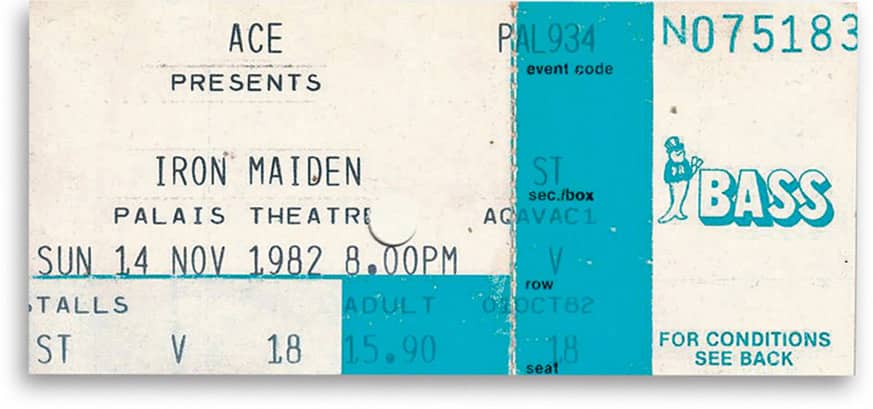
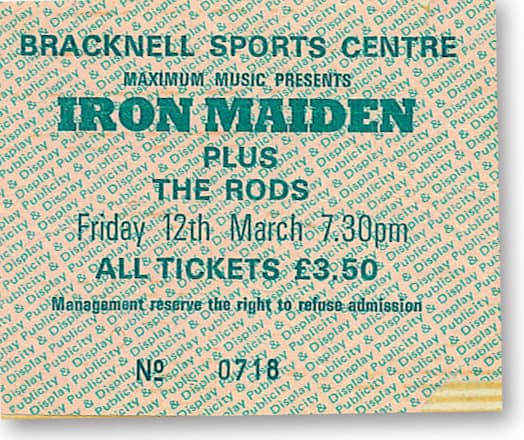
Notes: An April 27, 1981, date in Winschoten, Holland, was cancelled due to low ticket sales. A sometimes reported April 29 date in Hannover was likely cancelled due to a conflict with the rescheduled Offenbach show. Additionally, Bushell reports that four German and three Scandinavian dates were cancelled in 1981. These would have been in late April and early May.
Unreliable sources list an April 13, 1981, show in Munich and an August 22, 1981, show in Baarle, Holland.
It is unlikely that the band played a sometimes reported show in Saarbrucken on April 20, 1981, because the distance to Saarbrucken from Douvaine and back to Toulouse is out of character for normal tour travel for that time. Additionally, there is no proof the band played or ever made plans to play a show at this location or on this date. Confusion regarding this date and location stems from a bogus bootleg titled Cross-Eyed Mary, which features official B-sides being passed off of as bootleg tracks.
It’s possible the French shows listed from August 26 to 31, 1981, never happened. In 1989 French publication Hard Force released a retrospective of metal shows in France that did not include these dates. Although it should be noted that September 1 in Orange was also not on that list, but it has been confirmed by a ticket scan and an attestment from a fan who attended the gig.
October 26, 1981, marked Dickinson’s live debut with the band.
According to the January 30, 1982, Sounds, a February 27 show in Cardiff, Wales, was cancelled because the venue’s roof collapsed.
Fan club magazine No. 4 shows an empty spot on a tour list where the April 14 and 15, 1982, dates in Nancy and Mulhouse, France, would have been listed (probably whited out). However, this still doesn’t solve a mystery. In magazine No. 3, Bruce claims the band “pulled out” of three gigs in southern France because of a collective band illness. More specifically, Garry Bushell wrote in his book that the band cancelled three gigs along the Cote d’Azur, the southeast coast of France. The band was only scheduled to play one gig in this area: Nice. However, the band’s gig in Montpellier was on the southwest coast, and the gig following that—Toulouse—is within reasonable driving distance from the southwest. No other gigs are nearby the Cote d’Azur, so these three might be those which Bushell writes about. One problem: The band did play Nice. A bootleg in circulation has Bruce clearly saying “Bonsoir, Nice.” This has caused significant confusion as to which dates were actually cancelled. If the “three dates” were not the two missing in magazine No. 4, then it could be the band postponed the Nice gig until April 1 (the only open date between Toulouse and Barcelona), or the band did play Nice on the originally scheduled date, and then cancelled Montpellier, Toulouse, and an unknown location along the Cote d’Azur. The band did have an open date (March 29) between Nice and Montpellier in which they could have squeezed in a show in Toulon or Marseille.